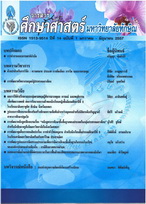ผลของการดื่มน้ำมะเม่าที่มีต่อระยะเวลาในการฟื้นตัวของชีพจีและสมรรถภาพทางกายของนักกีฬา
Main Article Content
บทคัดย่อ
การวิจัยเร่องผลของการดื่มน้ำมะเม่าที่มีต่อระยะเวลาในการฟื้นตัวของชีพจรและสมรรถภาพทางกายของนักกีฬา มีความมุ่งหมายเพื่อ 1) ศึกษาผลของการดื่มน้ำมะเม่าที่มรต่อระยะเวลาในการฟื้นตัวของชัพจรและสมรรถภาพทางกายของนักกีฬา 2) ศึกษาเปรียบเทียบผลของการดื่มน้ำมะเม่าที่มีต่อระยะเวลาในการฟื้นตัว ระหว่างกลุ่มที่ไม่ได้ดื่มน้ำมะเม่า (กลุ่มควบคุม) และกลุ่มที่ดื่มน้ำมะเม่า(กลุ่มทดลอง) 3)ศึกษาเปรียบเทียบผลการดื่มน้ำมะเม่าที่มรต่อสมรรถภาพทางกายของนักกีฬา ระหว่างกลุ่มที่ไม่ได้ดื่มน้ำมะเม่า (กลุ่มควบคุม) และกลุ่มที่ดื่มน้ำมะเม่า(กลุ่มทดลอง) กลุ่มตัวอย่างเป็นนักกีฬาฟุตซอลหญิง มหาวิทยาลัยมหาสารคาม จำนวน 12คน แบ่งเป็นกลุ่มควบคุม จำนวน 6 คน และ การวิ่งระยะทาง 800 เมตร และแบบทดสอบสมรรถรถภาพทางกายฮาร์วาร์ด สเตป เทสต์ สถิติที่ใช้ในการวิเคราะห์ข้อมูล ได้แก่ ร้อยละ ค่าเฉลี่ย ส่วนเบี่ยงเบนมาตรฐาน Wilcoxon Signed Rank Test และ The Mann-Whitney U-test
ผลการวิจัยปรากฏดังนี้
1. ผลของการดื่มน้ำมะเม่าที่มีต่อระยะเวลาในการฟื้นตัวของชีพจรและสมรรถภาพทางกายของนักกีฬาผลปรากฏดังนี้
1.1 พบว่า ค่าเฉลี่ยของระยะเวลาในการฟื้นตัวของชีพจรของนักกีฬาในกลุ่มควบคุมก่อนการทดลองมีค่าเฉลี่ยเท่ากับ 8.67 นาที หลังการทดลอง มีค่าเฉลี่ย 7.67 นาที ส่วนกลุ่มทดลอง ก่อนการทดลอง มีค่าเฉลี่ยเท่ากับ 8.33 นาที และหลังการทดลอง มีค่าเฉลี่ยเท่ากับ 7.33 นาที
1.2 พบว่าค่าเฉลี่ยของสมรรถภาพทางกายของนักกีฬาในกลุ่มควบคุม ก่อนการทดลอง มีค่าเฉลี่ยเท่ากับ 98.01 และหลังจากการทดลอง มีค่าเฉลี่ยเท่ากับ105.91 ส่วนกลุ่มทดลอง มีค่าเฉลี่ยเท่ากับ 92.86 และหลังจากทดลอง มีค่าเฉลี่ยเท่ากับ 105.58
2.ระยะเวลาในการฟื้นตัวของชีพจรของนักกีฬาภายในกลุ่มควบคุม ระหว่างก่อนการทดลองกับหลังการทดลอง พบว่า ระยะเวลาในการฟื้นตัวของชีพจรก่อนและหลังการทดลองไม่แตกต่างกัน ส่วนกลุ่มทดลอง พบว่า ระยะเวลาในการฟื้นตัวของชีพจรหลังจากการทดลองต่ำกว่าก่อนการทดลองอย่างมีนัยสำคัญทางสถิติ ที่ระดับนัยสำคัญ .05
ส่วนระยะเวลาในการฟื้นตัวของชีพจรของนักกีฬาระหว่างกลุ่มควบคุม กลุ่มทดลอง พบว่า หลังการทดลองกลุ่มทดลองมีระยะเวลาการฟื้นตัวของชีพจรต่ำกว่ากลุ่มควบคุม อย่างไม่มีนัยสำคัญทางสถิติ
3.สมรรถภาพทางกายของนักกีฬาภายในกลุ่มของกลุ่มควบคุมและกลุ่มทดลอง และระหว่างก่อนการทดลองกับหลังการทดลอง พบว่า สมรรถภาพทางกายภายในกลุ่มควบคุมและกลุ่มทดลองเปลี่ยนแปลงเพิ่มขึ้นอย่างมีนัยสำคัญทางสถิติ ที่ระดับนัยสำคัญ .05
ส่วนสมรรถภาพทางกายของนักกีฬาระหว่างกลุ่มควบคุมกับกลุ่มทดลอง พบว่า สมรรถภาพทางกายของกลุ่มทดลองหลังการทดลองเปลี่ยนแปลงเพิ่มขึ้นไม่แตกต่างกัน
The Effect of Drinking Ma-maow Juice on the Recover Time of Hart Rate and Physical Fitness of Atheletes
The research Was to study the effect of drinking ma-maow juice on the recovery time of hart rate and physical fitness of athletes its objectives were:
1)to study the effect of drinking ma-maow juice on the recovery time of hart rate and physical fitness of athletes 2) to compare the effect of drinking ma-maow juice on the recovery time of hart rate between groups of athletes who do not drink ma-maow juice (control) and drink ma-maow juice (treat) and 3)to compare the effect of drinking ma-maow juice on physical fitness between groups of athletes who do not drink ma-maow juice (control) and drink ma-maow juice (treat). The sample consisted 12 footsall female athletes of Mahasarakham University. The 6 athletes were control group and 6 athletes were treat group. Two types of the instruments used in this study were: 1)the running 800 meter 2)the Harvard Step test. The data was analyzed by the uses of mean, standard deviation. Wllcoxon
Signed Rank test and The Mann-Whitney U-test.
The study results were as follows:
1.The effect of drinking ma-maow juice on the recovery time of hart rate and physical fitness of athletes.
1.1 The mean of the recovery time of hart rate in control group of pre-test and
pre-test was 8.67 min and 7.67 min. respectively. Meanwhile. The mean of the recovery time of hart ratt in treat group of pre-test and post-test was 8.33 min and 7.00 min, respectively.
1.2 The mean of physical fitness in control group of pre-test and pre-test was 98.01 and 105.91, respectively. Meanwhile. The mean of physical fitness in treat group of post-test was 92.86 and 105.58, respectively.
2. The recovery time of hart rate in control group between pre-test and post-test, it was found that the recovery time of hart rate in post-test was not different when compared to pre-test. Meanwhile, the recovery time of hart rate in treat group between pre-test and post-test, it was found that the recovery time of hart rate in post-test was significantly (P0.05) lower than pre-test.
The recovery time of hart rate between control group and treat group, it was found that the recovery time of hart rate of post-test in control group was lower than treat group.
3. The physical fitness in control group and treat group between pre-test and post-test, it was found that the physical fitness in control group and treat group increased significantly
(P 0.05)
The physical fitness between control group and treat group, it was found that the physical fitness of control group increased no significant difference when compared to treat group.
Article Details
ในกรณีที่กองบรรณาธิการ หรือผู้เชี่ยวชาญ ซึ่งได้รับเชิญให้เป็นผู้ตรวจบทความวิจัย หรือ บทความทางวิชาการมีความเห็นว่าควรแก้ไขความบกพร่อง ทางกองบรรณาธิการจะส่งต้นฉบับให้ ผู้เขียนพิจารณาจัดการแก้ไขให้เหมาะสมก่อนที่จะลงพิมพ์ ทั้งนี้ กองบรรณาธิการจะยึดถือความคิด เห็นของผู้เชี่ยวชาญเป็นเกณฑ์


